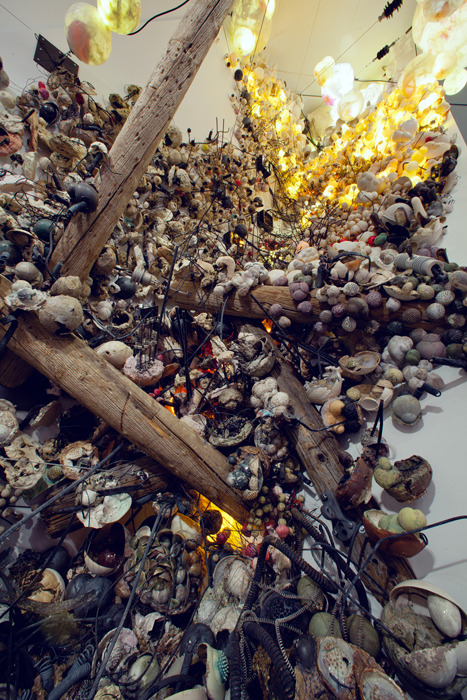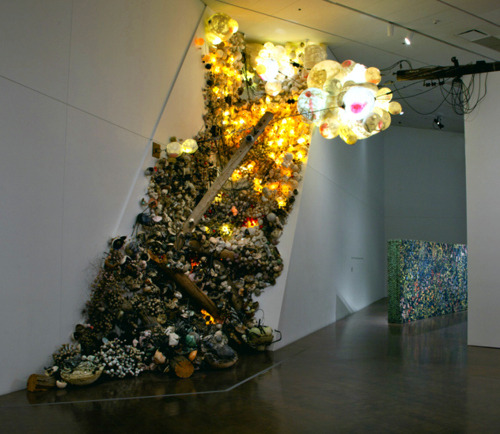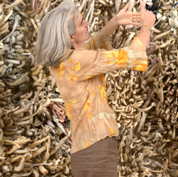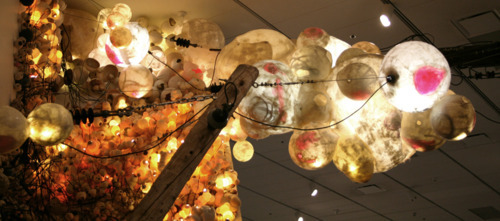
Martha Russo and Katie Caron, Apoptosis (detail), 2010–11. Photo by Jeff Wells.
Your collaboration transformed into an outstanding piece of contemporary art, Apoptosis. What can you tell us about this collaborative work?
Working in collaboration with Martha Russo was such a positive and inspiring experience. We have known each other’s work for years, and always seem to be following similar paths and forms. It was exciting to work with someone who is so on the same page as you. For example, the day I did my preliminary sketch of the work on an airplane ride to Detroit, Martha created a small model of the work. We were shocked to discover, that separate from each other, we both sketched pretty much the same piece.It was quite eerie!
Artist Statement for Apoptosis
The site-specific installation connects the museum’s own architecture to a floating swirl of motivated chaos made from a host of ceramic and mixed media materials. Apoptosis references the genetically directed process of cell self-destruction that makes way for new growth to occur.
Evoking growth and development, lightness and weight, the work suggests both biological membranes and intertwining industrial lines, conjuring up a tangle of beauty, grotesquerie, buoyancy, and energy.
The suspended composition has a brace of vantages: the first, a treasure-mesh conceals from the viewer the cryptic viscera of this complex organism, while the second vantage unfolds and unfurls, being pulled by gravity and holding the viewer in a state of suspended wonder.
Apoptosis looks powerful, twisted, and somehow embrace you to look further. Maybe it’s because of Katie’s previous works that experience illusions, or because of Martha’s work with the physical nature of sculpture?
Both of our goals were to engage the viewer to look further but in different ways. My previous work, as you mentioned, involves the creation of illusions where the viewer is asked to question: what’s real and what’s fabrication? I am fascinated with our cultures need for escapism, and how we have become addicted to the virtual windows of social media and entertainment. I hope to tap into this obsession, using theatrical effects to create objects and environments that entice the viewer to look closer and longer. Asking how virtual objects may compete with virtual media?
Is this a site project? Did you experience any challenges? (here you can tell us when did you start working on it, or how was the process, if you had any difficulties with the space, etc.)
Selection of the space came first, and then the concepts of the work. We were interested in using a space that had never been used to show work, a space that was unusual. The architecture of the Denver Art Museum is so powerfully unique, and so we chose a 30 foot slanted wall as our catalyst.
I began drawing concept sketches for forms, materials, and use of the space. I wanted to create an installation that looked like it was co-dependant, both foreign to the space, but dependent on the space for survival. I compare it to animal architecture; the way some insects parasitically transform man-made spaces to suit their needs.
The Denver Art Museum was a huge technical support to our installation. They provided us with the necessary lifts, equipment, and assistance to stage such a complex work. Mounting the utility poles took some serious preparation and support. There are over 200 lit porcelain and paper forms, plus another 3,000 other components mounted on the 30 foot slanted wall with steel rods. The installation was quite labor intensive to say the least.
What do you think about the Overthrown: Clay Without Limits exhibition?
It has been an honor to exhibit with such a prominent group of artists. Gwen Chanzit, the curator for Overthrown: Clay Without Limits, has done an admirable job of selecting and encouraging artists to be ambitious. The scale of the space has pushed all the artists to think big, both physically and conceptually. The exhibition, technically demonstrates the inventive use of such an ancient material, while raising contemporary issues. The works in the exhibition challenge traditional notions of “objectness”, providing a depth of content and creating a diverse dialogue.
Where do you get your inspiration from and what motivates you, what do you want to discover through your works?
We started off with the idea of a chaotic tangle, which led us to look at all kinds of forms, both from biology and industry. My personal interest was in power lines. For years, I have looked upward at utility poles and found their functional aesthetic inspiring. After undergoing major spinal surgery in 2009, and looking at x-rays of all the hardware in my back, I began to draw connections between the aesthetics of my hardware and the power lines. Both aesthetics were determined by utility and appeared parasitic to their host forms.
While creating the work, I discovered I was pregnant. I believe this change in my biology positively affected the work to create an illusion that the work was alive, and powered by an external energy force. Creating cell-like forms with illuminated interiors became my focus for the work.

Where can we find you and your works in the next future?
We are currently looking for another site for the work on both east and west coasts. I have two solo shows in 2012 in Denver, at Ice Cube Gallery and Hinterland Gallery, where I look to explore the progression of these ideas and materials further. You can find my work online at http://www.icecubegallery.com/ , and http://www.katiecaron.com/
Please give an advice to young ceramic artists.
My advice to young ceramic artist is two-fold: First, make, make, make! Ceramics is such a challenging material, so practice exploring all the ways to manipulate the clay is very important. Don’t be afraid to fail or let the work lead you. Too often, ceramic artists try to control the clay, rather than to use it as a guide. Second, explore other materials as well! Do not limit yourself to just clay, but build confidence with other materials, processes and concepts. The more interdisciplinary your work becomes, the more questions it can raise.
MARTHA RUSSO:
Your collaboration transformed into an outstanding piece of contemporary art, Apoptosis. What can you tell us about this collaborative work?
We both started with something that we wanted to investigate from previous works. For Katie is was light and translucent porcelain and paper and for me it was clay combined with metal. We would work independently in our studios and then show each other what we had done and then make more work off of what each other responded to. Conceptually, we started with the word “tangle” and sent each other a flurry of images of any kind of tangle. Our “image swap” generated a rolling progression of ideas and possibilities. What began to resonate with both of us were notions of electricity and wires, morphing cell production, masses of jumbled objects, and much more. We tested different groupings of the pieces in our studios and got a sense of how to make them physically cling to the wall. With time our ideas began to coalesce into a hazy notion of what the thousands and thousands of pieces would form. Because of the enormous scale (30 feet high and 25 feet wide) we really did not know how the installation would work until we put it up in the museum. I think the most important thing about our collaboration is that Katie and I gave each other complete freedom. We deeply trusted each other. Working with Katie has and continues to be a complete joy and one of incessant wonder and possibility. I feel infinitely fortunate to know and work with her. The future is BIG.
Apoptosis looks powerful, twisted, and somehow embraces you to look further. Maybe it’s because of Katie’s previous works that experience illusions, or because of Martha’s work with the physical nature of sculpture?
I think Apoptosis is a wonderful hybrid of our aesthetics, ways of working, trust in the unknown, and ideas about art.
I just learned of a new word, phototaxis, which means that light compels one to move closer to an object. I think the mystery and lure of the glowing porcelain forms and the hovering translucent paper spheres draws the viewer in closer to decipher the mass and weight of the cascade of objects, the jumble of metal burned into the clay coupled with the odd beauty and decisive scale of the utility poles. I think Katie and I share the fascination and try to mind the psychology of what intrigues someone to stay with a work of art.
Is this a site-project? Did you experienced any challenges? (here you can tell us when did you start working on it, or how was the process, if you had any difficulties with the space, etc.).
Because of so many conceptual crossovers and interests in experimenting with materials, Katie and I toyed with the idea of some day doing some work together. When we were invited to the show, separately, the thought of having such a huge gallery space seemed like a great opportunity to collaborate. After we decided to work together, we picked the space, which had not been used before to exhibit work. The prospects of such an unusual space set us in motion. I was most interested in creating some kind of wave of objects that would appear to have tumbled down the slanted thirty foot wall and Katie had the brilliant idea to connect an existing free-standing gallery wall to the slanted wall with some sort of floating forms.
The turn-around time for the show was about eleven months, so we had no time to waste. The time pressure really made us work quickly and intuitively while also solving a plethora of technical challenges like using translucent porcelain, learning how to cast and create forms with paper, and coaxing the clay to co-mingle with lots of different kinds of metal. The process was all about discovery – brilliant fun and incessant challenges. With a very carefully orchestrated plan, full support from the Denver Art Museum every step of the way, and an extremely smart, professional, and adventurous installation crew, the knitting together of the thousands of forms went off really well. Each day brought different challenges and unknowns and after two solid weeks of installing, Apoptosis came into focus.

What do you think about the Overthrown: Clay Without Limits exhibition?
The exhibit, curated by Dr. Gwen Chanzit, is smart, diverse, beautiful, and eye-opening. With every turn in the gallery, there is something really compelling to experience and to ponder. The show gives a fresh look into the contemporary art world at artists who use the clay process in some innovative and inventive ways. Being included in the exhibit has not only been and continues to be a great honor but has opened up a breath of possibilities for the future.
Where do you get your inspiration from and what motivates you, what do you want to discover through your works?
Here is the short list:
not knowing
cellular complexity and simplicity
a burl on a tree
logs jammed in a river bend
the odd hardware and connective gear on utility poles
the periodic table
the miracle of systems in the body
how my kids explore things
goo and glue and Dragon Skin
my husband, Joe, the scientist telling me about how chemicals interact
how to negotiate with the water content of clay
being a pyro
the light of the moon eking out behind the clouds

Martha Russo and Katie Caron, Apoptosis, 2010–11. Photo by Jeff Wells.
Where can we find you and your works in the next future?
In the upcoming year, I may be in exhibitions in Seattle, Denver, and Aspen. I am in an art collective, called “Artnauts, which is a group of artist put together by Dr. George Rivera and Garrison Roots, from University of Colorado, Boulder. This year we have shows in Chile, Cuba, Brazil, and two venues in the Middle East. To see more of my work please go to: http://www.martharussostudio.com/
Please give an advice to young ceramic artists.
WORK WORK WORK and WORK SOME MORE. Making anything takes a long time. Staying in the studio and staying with a new idea or process simply takes time, concentration, and focus. Avoid editing away ideas too early. Give everything a long incubation period with unfettered flurries of making and then look at the work carefully. And lastly, be open to every possible material and process in order to bring an idea to fruition. Plus have fun.

Apoptosis, 2010-2011
Porcelain, paper clay, glaze materials, colored pigments, assorted tools, steel and hardware, silicone, LED Lights, compact fluorescents, electrical cables, wires and conductors, utility poles, abaca paper, beeswax.
Apoptosis is a floating swirl of motivated chaos that inhabits the museum’s architecture. The cascading mass of morphing cell-like forms evokes growth and development, lightness and weight, and connects biological membranes with intertwining industrial lines. With a cacophony of sculptural forms, colors, textures, cables, utility poles, and lights it conjures up a tangle of beauty, grotesquerie, buoyancy, and energy. Our goal is to create a state of suspended wonder.

Katie Caron
Born 1978 in Manchester, Connecticut; lives in Lafayette and works in Lakewood, Colorado
Katie Caron graduated summa cum laude from Boston University in 2000 and received an MFA in ceramics from Cranbrook Academy of Art in 2009. Her work has been in national exhibitions such as Breakdown at Guggenheim Gallery: Chapman University, California, Reinventing Beauty at the Museum of New Art: MONA, Michigan, and Elastic Authenticity at the Morean Art Center in St. Petersburg, Florida. Caron is presently an Assistant Professor in Fine Arts & Art Education at Rocky Mountain College of Art & Design, and a member of Ice Cube Gallery. She lives with her husband in Lafayette, CO.
I am fascinated by escapism: how and why our senses transport us to imaginary worlds, how electronic media change the way we feel the present moment and how it can mediate our lives. Through film and theatrical effects, I immerse viewers in the experience of an illusion—what’s real and what’s fabrication?
These new worlds are uncanny and mysterious. I explore how unconscious reactions shape emotion; how certain spaces, sounds, and objects may provoke fear or incite wonder.

Martha Russo
Born 1962 in Milford, Connecticut; lives in Ward and works in Lakewood, Colorado
Martha Russo earned a BA in developmental biology and psychology from Princeton University,1985. Formerly a world-class athlete, she suffered a career-ending injury in 1984 while preparing for the Los Angeles Olympic Games. After her recovery from surgery, attracted to the physical nature of sculpture, Russo studied studio arts in Florence, Italy, and continued at Princeton University. In 1995, she earned her MFA at the University of Colorado, Boulder. Martha is represented by Allan Stone Gallery, New York, New York and Ron Judish, Denver, Colorado. Martha also teaches at Rocky Mountain College of Art and Design, Lakewood, Colorado.
Before children have the language and cognitive skills to name an object, they explore the world with all of their senses. For instance, a chair is not a “chair” but rather something to climb on, to crawl under, and, perhaps, even to lick. With the acquisition of language and the awareness of the purpose of something, the investigations dwindle and the senses simmer. My hope is that people approach my work and stay with it because they are not quite sure what it is: What are the forms? What are they made out of? How are they suspended in space? I make abstract organic sculptures to give people a place to let language and purpose slip away and to allow the senses to frolic, to delight, to muse.
By Vasi Hirdo.
Published in Ceramics Now Magazine Issue 1.
Visit Katie Caron and Martha Russo’s websites.





















